Lens User Survey: The Voice of Our Community
As we prepare to launch our new annual user survey, we want to take a moment to reflect on last year’s results and how they’ve shaped the Lens experience over the past 12 months. Your feedback has been invaluable, helping us fine-tune our product and focus on what matters most to you. Before we dive into our new survey, let’s look back at the insights from 2023 and celebrate the impact your input has had. This time, we’re even more excited to hear from you and continue making Lens the ultimate tool for cloud-native development.
Who Are The Users of Lens?
Our community of Lens users is a microcosm of the broader cloud-native ecosystem. The diversity in roles, experience, and company sizes reflects the evolution and widespread adoption of Kubernetes and cloud-native technologies globally.
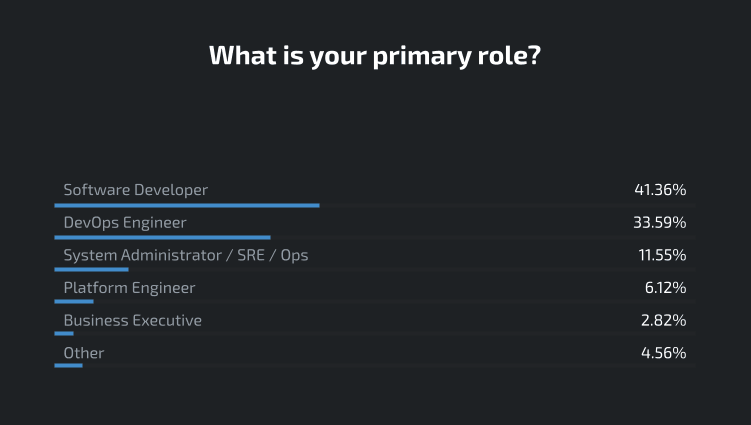
- 41% of you are Software Developers, the architects of the future. As Kubernetes becomes the backbone of cloud-native development, developers are increasingly involved in the operational side of the equation, taking more control of how their applications are deployed, managed, and scaled.
- DevOps Engineers and System Administrators/SREs make up a combined 45% of our user base. This aligns perfectly with the ongoing shift toward infrastructure as code (IaC) and the growing demand for streamlined operations in the cloud-native space. Lens’s ability to simplify complex Kubernetes environments has made it a favorite among these users who juggle deployment pipelines, infrastructure management, and operational stability.
- Platform Engineers represent 6% of our users, and this segment is rapidly growing. As platform engineering emerges as a key trend in large organizations, we see Lens being adopted by teams building and maintaining internal developer platforms, designed to abstract away the complexities of Kubernetes for end users.
- Interestingly, Business Executives also make up 2.82% of our user base, signaling the rising strategic importance of Kubernetes and cloud-native technologies at the executive level. As more organizations embrace digital transformation, these decision-makers are increasingly involved in technology adoption and operational choices that impact the entire business.
This user base not only demonstrates the versatility of Lens but also mirrors trends we’re seeing across the broader cloud-native landscape. The rise of platform engineering, the shift toward developer-centric operations, and the inclusion of business stakeholders in cloud-native strategies all point to Kubernetes continuing its march toward mainstream adoption.
Organization Size: A Wide Spectrum of Cloud-Native Adoption
One of the most exciting aspects of our community is the wide variety of organization sizes using Lens. This reflects how Kubernetes, once the domain of early adopters and large enterprises, is now being embraced by businesses of all sizes, from solo developers to global enterprises.
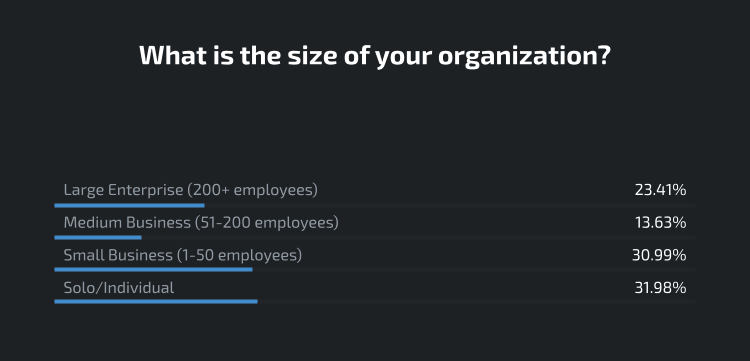
- 31.98% of our users are solo developers or individual consultants. This significant percentage showcases a trend we've seen across the cloud-native ecosystem: Kubernetes is no longer just for large teams. Individuals working independently or on small teams are leveraging its power to build, manage, and scale applications as efficiently as their larger counterparts. Tools like Lens have become crucial for solo developers, enabling them to manage Kubernetes environments without the steep learning curve traditionally associated with these technologies.
- 30.99% of you work in small businesses (1-50 employees). Cloud-native tools like Kubernetes are increasingly becoming accessible to smaller organizations, allowing them to innovate and compete with larger enterprises. The adoption of Kubernetes by small businesses is driven by the flexibility and scalability it provides—allowing them to grow without the need for massive upfront infrastructure investments. Lens plays a critical role here, simplifying Kubernetes management so these teams can focus on delivering value rather than operational overhead.
- 13.63% of our users are from medium-sized businesses (51-200 employees). For these organizations, Kubernetes represents a powerful way to scale their operations while maintaining agility. Medium-sized companies often face the challenge of managing more complex infrastructure than small businesses but without the dedicated resources of large enterprises. With Lens, these teams are able to manage their Kubernetes clusters effectively, making cloud-native technologies accessible even to teams with smaller operations or DevOps functions.
- 23.41% come from large enterprises (200+ employees), which is no surprise given the widespread enterprise adoption of Kubernetes over the last few years. Large enterprises are using Kubernetes to modernize their legacy infrastructure, manage large-scale applications, and drive digital transformation initiatives. These organizations need tools that can help them manage complex multi-cluster environments, and Lens has proven to be a valuable asset in making Kubernetes more approachable and efficient for teams within these large, distributed businesses.
This broad distribution of organization sizes reflects a key trend in the cloud-native world: Kubernetes has become a ubiquitous tool, no longer reserved for just the tech giants or early adopters. Whether it’s a solo developer building out a new app or a global enterprise running mission-critical infrastructure, Lens is there to support them on their cloud-native journey. We’re proud to see such diversity in our community and are excited to continue evolving Lens to meet the needs of every user, no matter the size of their organization.
Kubernetes Experience: A Journey from Beginner to Expert
One of the most interesting aspects of our survey results is how Lens caters to users at every stage of their Kubernetes journey, from those just starting to experts managing complex environments. This diversity reflects a broader trend in the cloud-native world, where Kubernetes adoption continues to grow, but the learning curve remains a challenge for many.
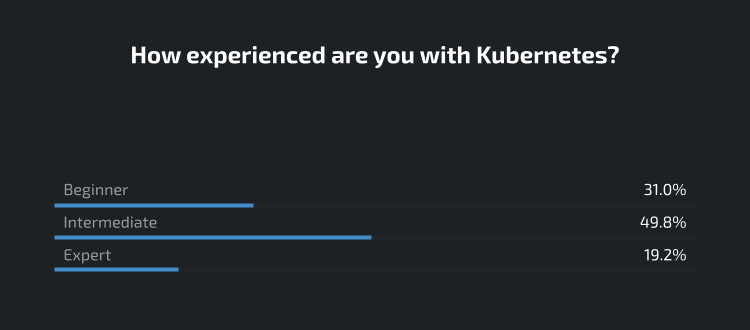
- 31% of our users identify as beginners in Kubernetes, which is a significant portion of our community. This mirrors a larger industry trend where more and more developers and DevOps professionals are stepping into the world of Kubernetes for the first time. As Kubernetes becomes the standard for container orchestration, its complexity can be daunting for new users. Lens helps bridge that gap, simplifying cluster management and making it easier for beginners to get up and running with Kubernetes without getting overwhelmed by the command line or intricate configurations.
- The majority of users—49.8%—consider themselves intermediate in Kubernetes. This group represents those who have gotten comfortable with Kubernetes basics and are now managing day-to-day operations or building applications on top of it. For many intermediate users, Lens acts as an indispensable tool that reduces the operational burden, allowing them to focus more on improving workflows, automating processes, and scaling their deployments. These users represent the heart of the Kubernetes ecosystem, where efficiency and productivity are key drivers of success.
- 19.2% of our users classify themselves as experts. These are the power users of Kubernetes who often manage complex, multi-cluster environments, architect systems for high availability, or run mission-critical workloads. As Kubernetes has matured, experts in the field are pushing the boundaries of what’s possible, and Lens helps them stay on top of their clusters with ease. Even for the most experienced users, the visual and intuitive interface of Lens simplifies cluster management, saving time and reducing complexity.
What’s fascinating about these results is that they reflect Kubernetes’s broader journey from a niche tool for cloud-native pioneers to a mainstream technology embraced by teams of all experience levels. The fact that Lens is being used by everyone from complete beginners to seasoned experts is a testament to how it empowers users at every step of their Kubernetes journey.
This trend aligns with what we see in the cloud-native ecosystem: Kubernetes is becoming the backbone of modern application infrastructure, but the need for simplifying tools is greater than ever. Whether you’re just starting out or a Kubernetes veteran, Lens is designed to help you get the most out of your clusters without the complexity, making cloud-native development more accessible and productive for everyone.
How Did You Hear About Us? Word of Mouth Rules!
One of the standout insights from our survey is how our community first learned about Lens. The results show that Lens’s growth has been driven largely by organic, community-driven engagement—a trend that mirrors how many successful open-source and developer-centric products spread in the cloud-native world.
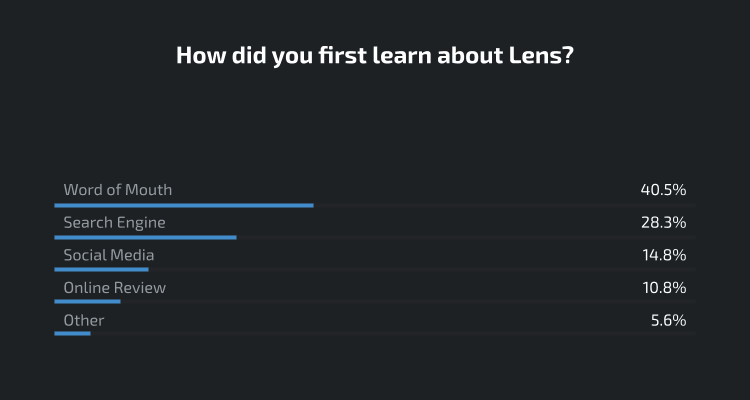
- 40.5% of you first heard about Lens through word of mouth, and that’s something we’re incredibly proud of. In the cloud-native space, developers and engineers are constantly sharing their favorite tools, best practices, and problem-solving techniques with colleagues and within the broader community. For us, word of mouth isn’t just a metric; it’s validation that Lens is delivering real value to our users. When people are so satisfied with a tool that they recommend it to their peers, it speaks volumes about its effectiveness. This organic growth has been the cornerstone of Lens’s success, and we’re committed to continuing to build a product worth talking about.
- 28.3% of users found Lens through a search engine, which highlights another key trend: as Kubernetes continues to grow in popularity, more people are actively searching for tools to simplify and streamline their cloud-native workflows. Developers are turning to search engines to solve specific problems, such as managing Kubernetes clusters or improving productivity, and Lens is increasingly showing up as a top result. This visibility is a testament to the growing recognition of Lens in the cloud-native ecosystem, as more users are seeking out tools that can simplify their day-to-day operations.
- 14.8% learned about Lens through social media, a platform that has become a vital space for developers to exchange ideas, share tools, and discover new technologies. Platforms like Twitter, LinkedIn, and developer forums have enabled rapid sharing of experiences, leading to increased visibility for Lens within the tech community. As Kubernetes continues to dominate conversations around cloud-native development, Lens’s presence in these discussions helps developers and teams discover its value.
- 10.8% found Lens through online reviews, a growing trend as developers look for third-party validation before adopting new tools. As cloud-native technologies proliferate, the number of tools available can be overwhelming. Online reviews—whether on developer forums, blogs, or software comparison sites—help potential users get a sense of the real-world effectiveness of tools like Lens. Positive reviews from other professionals in the field lend credibility and give prospective users the confidence to try Lens in their own environments.
- The remaining 5.6% discovered Lens through other channels, including conference talks, webinars, and community meetups. The cloud-native space is known for its vibrant community and frequent events, and Lens has benefitted from visibility at industry conferences like KubeCon, where Kubernetes practitioners gather to share knowledge and best practices. By being active in the community, we ensure that Lens stays at the forefront of cloud-native discussions, offering practical solutions to the challenges developers face every day.
This variety in how users find Lens reflects the broader trends in how cloud-native tools are discovered and adopted. Community-driven growth, bolstered by search engines and online reviews, plays a critical role in the adoption of developer-centric products like Lens. As the Kubernetes ecosystem continues to expand, Lens’s presence in these channels ensures that more users can discover, adopt, and benefit from the tool, whether through a recommendation from a friend, a social media post, or a well-timed search.
Lens Usage: A Daily Essential for Cloud-Native Teams
The frequency with which our users rely on Lens shows just how integral it has become to daily workflows. Whether you’re a solo developer managing Kubernetes clusters or part of a large operations team, Lens has become an essential tool for simplifying and streamlining cloud-native operations.
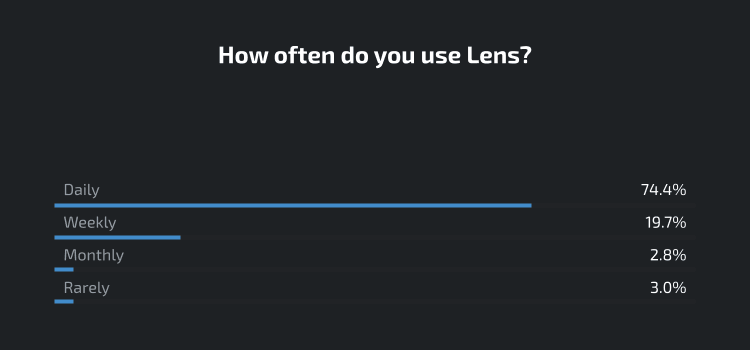
- A remarkable 74.4% of users report using Lens daily. This statistic speaks volumes about how deeply Lens is embedded in day-to-day Kubernetes workflows. As organizations continue to shift toward containerized applications and microservices architectures, Kubernetes has become the operational backbone. However, managing Kubernetes manually can be challenging and time-consuming. Lens simplifies these tasks by providing a visual interface, easy cluster management, and features that reduce the complexity of day-to-day operations. For many, Lens has become the go-to tool for navigating the complexities of Kubernetes clusters—whether it’s monitoring performance, deploying new applications, or troubleshooting issues.
- 19.7% of users utilize Lens on a weekly basis. While these users might not need daily interaction with their Kubernetes clusters, Lens still plays a critical role in their recurring management cycles. This could include tasks like scaling applications, reviewing cluster health, or making infrastructure changes. The ability to dive into Kubernetes management without needing to dig through command-line tools every time allows these users to stay efficient and focused on their core responsibilities, even if their interaction with Kubernetes is less frequent.
- 2.8% report using Lens monthly, and 3.0% use it only rarely. Even for those who don’t need to interact with Kubernetes as frequently, Lens provides a reliable tool for periodic maintenance or when they need to resolve an urgent issue. These users are often in roles where Kubernetes isn't their primary focus but having an easy-to-use tool like Lens ensures they can jump into cluster management as needed without having to refresh their knowledge each time.
These usage patterns reflect a key trend in cloud-native operations: Kubernetes is becoming a central piece of infrastructure management, and as teams scale their use of containers, they need reliable, daily-accessible tools to stay on top of their environments. For many developers and DevOps professionals, Kubernetes is no longer an occasional task—it’s part of their everyday work, and Lens provides the operational simplicity and efficiency they need to be productive.
As organizations increasingly adopt Kubernetes as their default platform for containerized workloads, the reliance on powerful, user-friendly management tools like Lens continues to grow. Whether you’re deploying new applications, managing existing clusters, or scaling your infrastructure, Lens helps ensure that your Kubernetes workflows are streamlined and efficient, making it an indispensable tool for cloud-native teams of all sizes.
How Important is Lens to Your Work? A Critical Tool for Cloud-Native Success
The results of our survey demonstrate just how essential Lens has become to the daily work of cloud-native developers, DevOps engineers, and operations teams. With Kubernetes now central to managing modern infrastructure, tools like Lens are not just nice-to-have—they’re vital for keeping clusters running smoothly, efficiently, and securely.
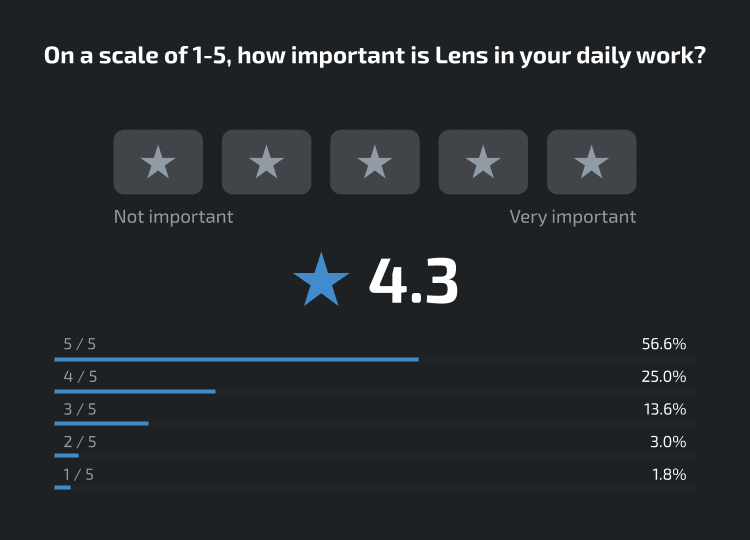
- 56.6% of users rated Lens as a 5/5 in terms of importance to their daily workflow. This overwhelming vote of confidence highlights the critical role Lens plays in simplifying Kubernetes management. As Kubernetes continues to grow in complexity, tools like Lens help users navigate multi-cluster environments, monitor application performance, and troubleshoot issues in real-time—all without the need for tedious, manual interventions through the command line. For these users, Lens is more than just a management tool; it’s become a daily companion, helping them save time, reduce complexity, and ensure their Kubernetes clusters are running optimally.
- 25% of users rated Lens as a 4/5, indicating that while it may not be used for every task, it still plays a significant role in their regular workflow. These users likely manage Kubernetes alongside other cloud-native tools, using Lens for specific tasks such as monitoring, troubleshooting, and cluster optimization. This reflects a broader trend in the developer tools ecosystem: while many tools are specialized for certain functions, Lens’s ability to consolidate multiple Kubernetes management tasks into a single, intuitive interface makes it a highly valuable resource even for users who have a diverse toolset.
- 13.6% of users gave Lens a 3/5, indicating it’s useful but perhaps not a daily necessity for all of their Kubernetes operations. This feedback aligns with the fact that some users may have smaller clusters or less frequent interaction with their Kubernetes environments, meaning they use Lens on an as-needed basis. These users typically rely on Lens for cluster insights, diagnostics, or when troubleshooting complex issues that require more visual context.
- The remaining 3% and 1.8% rated Lens as 2/5 or 1/5, which might reflect teams or users with very specific or specialized needs outside of what Lens currently offers. For some users, especially those in highly customized environments, Lens may be a supplemental tool rather than a core part of their workflow. However, this feedback helps us identify areas for improvement and future features that could expand Lens’s utility for these users.
These ratings reflect a broader industry shift: as organizations adopt cloud-native architectures, they are increasingly relying on tools that reduce complexity and operational friction. Kubernetes is a powerful platform, but without the right tools in place, it can quickly become overwhelming to manage. Lens helps mitigate that complexity by providing users with a clear, visual interface that makes Kubernetes management more intuitive and accessible, whether you’re a solo developer or part of a large DevOps team.
As Kubernetes continues to gain traction across industries and companies of all sizes, the need for reliable, easy-to-use tools like Lens will only grow. By simplifying the complexities of cloud-native environments, Lens empowers developers and operations teams to focus on what really matters—building and running applications that drive business value. Your feedback in this area confirms that Lens is not just a helpful tool, but a critical asset in the day-to-day operations of our users.
Your Feedback Shapes the Future of Lens
Last year’s survey wasn’t just about collecting data—it was about understanding your needs, challenges, and ideas for how Lens can continue to improve. We received a wealth of insightful suggestions from you, covering everything from user interface enhancements to advanced features that would make Kubernetes management even more seamless. Here’s a snapshot of some of the ideas you shared:
- Enhanced filtering across different resource types, making it easier to focus on specific tasks even when switching between views.
- The ability to export data from various views, allowing for faster backups, data transfers, and audits.
- Requests for a web version of Lens, reflecting the growing demand for flexibility and remote access across multiple environments.
- Additional integrations to expand functionality and improve workflow efficiency.
- Better customization options for the UI, with features like customizable columns and multiple views to enhance usability and navigation.
We’ve heard you loud and clear, and many of these suggestions have already been implemented in the latest version of Lens. The remaining ideas are helping shape the next steps in our product roadmap. Whether it’s improving resource utilization visibility, adding support for more environments and integrations, or making Lens even more intuitive for managing multiple clusters at once, we are committed to turning your feedback into action.
The Lens community’s insights have always been a driving force behind our development. Your contributions ensure that Lens continues to evolve in ways that matter most to you. We’re excited to see what new ideas emerge in this year’s survey and to keep building features that make your cloud-native journey smoother, faster, and more productive.
Closing Thoughts: We Need Your Voice for the Future of Lens
As we look back on last year’s survey results, it’s clear that your feedback has been instrumental in shaping the future of Lens. Your insights help us understand what’s working, what can be improved, and what new features will make your Kubernetes management even more efficient and enjoyable.
Now, we’re excited to announce that we’re launching our brand-new 2024 Lens User Survey, and we’d love for you to participate. Just like before, the survey will be available directly in the Lens app, so keep an eye out for an invitation in the coming days and weeks. Your participation is crucial—it helps us continue evolving Lens in ways that serve you best.
Whether you’ve been with us from the beginning or are new to the Lens community, your input will guide our roadmap and ensure that Lens continues to meet the needs of cloud-native professionals like you. Thank you for being a part of this journey, and we can’t wait to hear your thoughts!
